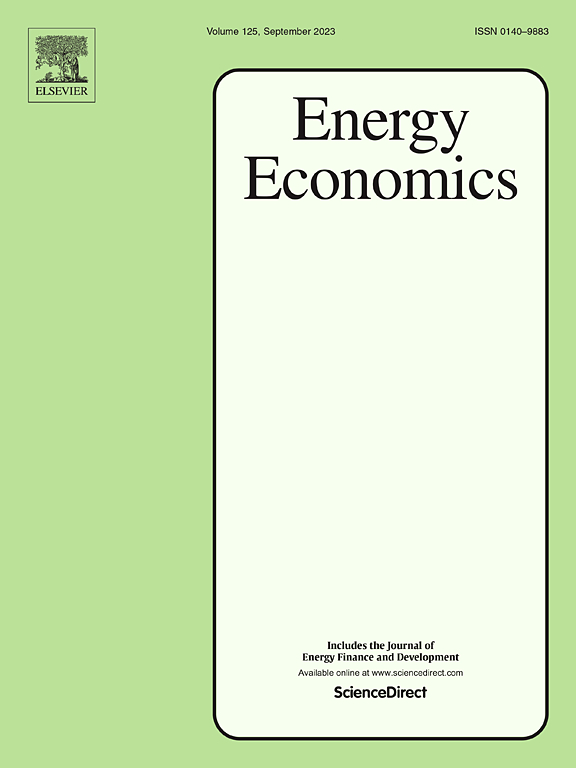Multiscale systemic risk spillovers in Chinese energy market: Evidence from a tail-event driven network analysis
IF 14.2
2区 经济学
Q1 ECONOMICS
引用次数: 0
Abstract
This paper investigates multiscale systemic risk spillovers in the Chinese energy market by combing the maximal overlap discrete wavelet transform (MODWT) with the tail-event driven network (TENET) model, which could analyze tail events and multiscale network dynamics. It creates multiscale extreme risk spillover networks consisting of energy companies in the coal, oil, natural gas, and new energy. To examine the transmission of risk between different subsectors and companies within the network, we assess overall, subsector, and company-level connectedness across different time scales, respectively. Empirical results show the OPEC oil production cut in 2017, the Sino-US trade war in 2018, the COVID-19 outbreak in 2020, and the Russia-Ukraine conflict started in 2022 boosted overall connectedness and concentration, suggesting that systemic risk connectedness tends to be intersectoral during market crises. The coal subsector appears to be the most integrated and exposed to systemic risk in the short term, while the oil subsector acts as the most influential subsector in the long term. The short-term risk spillover of the new energy subsector from 2018 to 2020 affects all energy subsectors, but it has moderated. The new energy subsector has a greater long-term impact on the energy market after 2020. Brent crude oil and domestic coal and LNG prices in China significantly drive systemic risk transmission in the Chinese energy sector, especially during the COVID-19 pandemic and the Russia-Ukraine conflict. This research may benefit governments, regulators, energy companies, and investors under different market conditions and investment horizons.
中国能源市场的多尺度系统性风险溢出:来自尾事件驱动网络分析的证据
本文将最大重叠离散小波变换(MODWT)与尾部事件驱动网络(TENET)模型相结合,研究了中国能源市场的多尺度系统性风险溢出,该模型可以分析尾部事件和多尺度网络动力学。形成了由煤炭、石油、天然气、新能源等能源企业组成的多尺度极端风险溢出网络。为了检验网络中不同子行业和公司之间的风险传递,我们分别评估了不同时间尺度上的整体、子行业和公司层面的连通性。实证结果显示,2017年欧佩克减产、2018年中美贸易战、2020年新冠肺炎疫情、2022年俄乌冲突等因素提升了整体连通性和集中度,表明在市场危机期间,系统性风险连通性往往是跨部门的。在短期内,煤炭分部门似乎是整合程度最高、面临系统性风险最大的部门,而从长期来看,石油分部门是最具影响力的分部门。2018 - 2020年新能源细分行业的短期风险外溢影响所有能源细分行业,但已有所缓和。新能源细分行业对2020年后能源市场的长期影响更大。布伦特原油以及中国国内煤炭和液化天然气价格在很大程度上推动了中国能源行业的系统性风险传导,特别是在2019冠状病毒病大流行和俄罗斯-乌克兰冲突期间。在不同的市场条件和投资视野下,本研究可使政府、监管机构、能源公司和投资者受益。
本文章由计算机程序翻译,如有差异,请以英文原文为准。
求助全文
约1分钟内获得全文
求助全文
来源期刊

Energy Economics
ECONOMICS-
CiteScore
18.60
自引率
12.50%
发文量
524
期刊介绍:
Energy Economics is a field journal that focuses on energy economics and energy finance. It covers various themes including the exploitation, conversion, and use of energy, markets for energy commodities and derivatives, regulation and taxation, forecasting, environment and climate, international trade, development, and monetary policy. The journal welcomes contributions that utilize diverse methods such as experiments, surveys, econometrics, decomposition, simulation models, equilibrium models, optimization models, and analytical models. It publishes a combination of papers employing different methods to explore a wide range of topics. The journal's replication policy encourages the submission of replication studies, wherein researchers reproduce and extend the key results of original studies while explaining any differences. Energy Economics is indexed and abstracted in several databases including Environmental Abstracts, Fuel and Energy Abstracts, Social Sciences Citation Index, GEOBASE, Social & Behavioral Sciences, Journal of Economic Literature, INSPEC, and more.
 求助内容:
求助内容: 应助结果提醒方式:
应助结果提醒方式:


